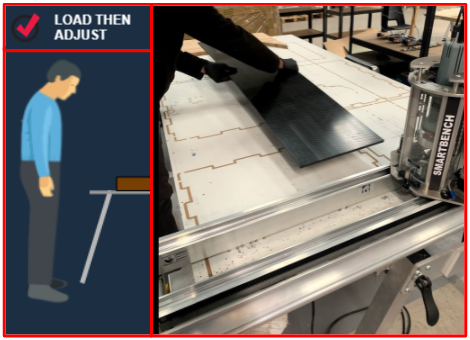This article explains the importance of proper lifting techniques when loading your stock material on SmartBench.
< Previous | List | Next >
Injuries due to lifting can have serious consequences. You could be putting your back, shoulders, knees and other joints at risk of injury.
To help prevent injuries in the workplace follow the proper lifting techniques.
Plan the lift before you start
Before lifting or carrying, think about:
-
How heavy is the load?
-
Does packaging need removing?
-
Is your workholding clear of obstacles to accept the stock material?
-
Do you need assistance in lifting the stock material?

|

|
Don’t be daft or try to show off! Now is not the time to test your limits - if you are in doubt about whether you can lift something safely, ask for help!
|
Lift from a stable position
Get as close to the stock material as possible.
Position your feet in a wide stance in order to develop more power while you lift and also to improve your balance and stability.
It is also important to not wear over-tight clothing or unsuitable footwear, which can make lifting more difficult.

Bend your knees rather than your back
At the start of the lift it is better to bend your knees and hips, and keep your back straight, so that you do not strain your back.
Tighten your abdominal muscles to stabilize through your core in preparation for the lift.
|

|
You should be aiming to keep your back straight, but not lock it out so much that you are lifting from a full squat.
In this scenario it would be better to have a slight bend in the back so as to avoid a strain on the hips or knees.
|

Keep the load close to your body
While lifting, keep the load close to your waist; this puts less strain on your back.
Avoid leaning, twisting, or bending your back as this places pressure on the spine.
Instead, move your feet to turn by keeping your whole body shoulders, hips, knees and toe facing the same direction.
Maintain your head level and look ahead, not down at the load, once you are holding it securely.

Put down, then adjust
Put down the stock material on the spoilboard or the bed of the Y Bench, without positioning it yet.
Once the weight of the stock material is fully supported by SmartBench, then do the finer adjustments to position it.

Use mechanical aids whenever possible
If possible, make use of lifting equipment, such as forklifts or pallet trucks. This will help with lifting and transporting heavy stock material.

< Previous | List | Next >